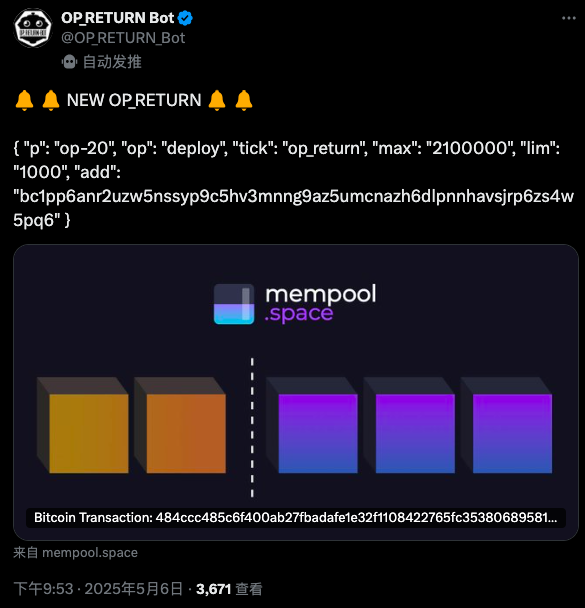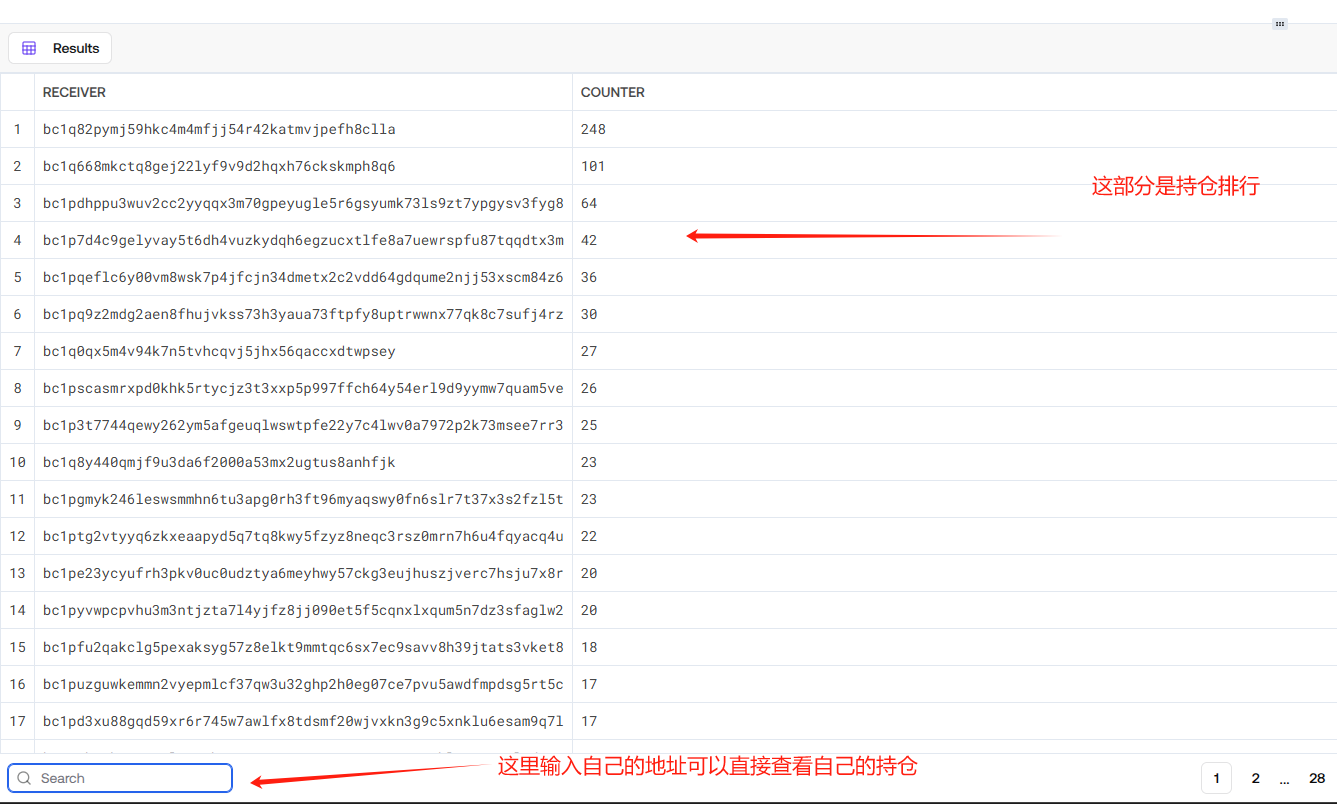BTC "small upgrade" triggers a 100-fold increase in the price of the OP-20 token, and the over-the-counter transaction price exceeds $400 per token|BTC Ecosystem
Original | Odaily Planet Daily ( @OdailyChina )
Author: Golem ( @web3_golem )

Is the sleeping lion about to wake up? This is the feeling of some deep players in the Bitcoin ecosystem recently.
A developer statement on May 6 showed that the next version of Bitcoin Core may abolish the 80-byte limit on OP_RETURN output. The statement said that the 80-byte limit on OP_RETURN is no longer suitable for current needs. First, it is easy to bypass, and some private mining accelerators do not enforce these restrictions at all; second, it will form a distorted incentive mechanism, and some projects will incentivize some private services in order to bypass the restrictions. At the same time, the statement said that abolishing the 80-byte limit on OP_RETURN has received widespread support.
Currently, a token deployment format OP-20 that breaks the 80-byte limit of OP_RETURN has appeared on the market. The over-the-counter transaction price of the token with the same name op_return has risen to US$400 per piece (1,000 per piece), while the cost is only US$5-6 per piece.
In this article, Odaily Planet Daily will briefly introduce what OP_RETURN is, what pros and cons it will have on the Bitcoin network after a successful upgrade, and what the prospects are for issuing OP-20 using this mechanism.
The debate surrounding OP_RETURN
In the Bitcoin network, OP_RETURN is a script operation code (opcode) specifically used to carry arbitrary data in transactions. The data carried by OP_RETURN output will not be referenced by subsequent transactions and will not occupy the node's UTXO space.
In the early days, Bitcoin nodes had to keep all unspent outputs (UTXO) permanently. Malicious or uncontrolled data writing would cause node storage pressure. Therefore, in 2013, the community proposed the idea of "lightweighting" data storage by adding an immediate invalidation script. Then in 2014, Bitcoin Core 0.9.0 officially included OP_RETURN output into the "standard output" type, and set the data limit to 40 bytes, which was gradually increased to 80 bytes in the future to balance data writing needs and network resource protection.
OP_RETURN restrictions no longer meet the needs of Bitcoin ecosystem development
Therefore, Bitcoin developers originally designed OP_RETURN to prevent nodes from over-expanding storage due to processing scripts containing large blocks of data, and used it as a "lightweight record of the blockchain" function. However, with the development of the Bitcoin ecosystem, various asset protocols, project parties, L2, and cross-chain bridges need to record more and more data on the chain, and the 80-byte limit of OP_RETURN has gradually become restrictive.
In order to meet project needs, various project parties have to bypass this limitation through various operations, including providing high rewards to miners, etc. Therefore, Bitcoin Core core contributor Greg Sanders released a statement on GitHub, proposing to remove the 80-byte limit in the next version of Bitcoin Core and allow OP_RETURN outputs of any number and length.
He believes that the removal of the 80-byte limit will bring at least two tangible benefits:
Cleaner UTXO collections. Data can now be placed in a single provably unspendable output, rather than disguised in a spendable script or scattered across multiple transactions.
Consistency of behavior. Nodes can relay transactions that miners want to see, making fee estimation and compact block relay more reliable.
Opposition remains strong
But in fact, Bitcoin Core has not yet officially announced the specific date of the next upgrade. At the same time, there are still many voices of opposition under the GitHub of the announcement upgrade.
Community member wizkid 057 said that this is far more than a small technical change, but a fundamental change to the nature of the entire Bitcoin network. The Bitcoin network will become an arbitrary data storage system instead of developing as a decentralized currency. At the same time, it will also make more data-intensive protocols (such as inscriptions, NFTs) and "junk" data more prevalent.
Upgrade not yet completed, coin issuance first
However, although the update to the next version of Bitcoin Core to abolish the 80-byte upper limit of OP_RETURN has not yet been finalized, a token deployment standard OP-20 that breaks this limit has quietly been launched, and the first token of the protocol, op_return, is suspected to have been minted. The current over-the-counter transaction price is US$400 per piece (1,000 pieces per piece), while the initial cost is only US$5-6 per piece, achieving a hundredfold "floating profit".

op_return was suspected to be deployed by the address bc 1 p...4 w 5 pq 6 on the evening of May 6, with a total of 2.1 million, a total of 2,100. As shown in the Bot push below, its token deployment format is no different from BRC-20, except that there is an additional address in the json text (this may also be the reason why OP-20 exceeds the 80-byte limit).

The format of the cast op_return is thus:
{ "p": "op-20", "op": "mint", "tick": "op_return", "amt": "1000", "add": "Here is your bitcoin address" }
The user pastes the text information into the OP_RETURN Bot website , and then uses the Lightning Network to pay to create an OP_RETURN output to complete the minting operation. Currently, the community speculates that op_return has been minted, but there is no official index or transaction transfer tool, and only over-the-counter double staking is available.
Regarding the index rules (the rules that determine whether you have made a move or not), some community players have listed two situations, one is the index that does not allow batch casting (i.e. multiple batches in 1 transaction), and the other is the index that allows batch casting .
 At the same time, some community players compared OP-20 with BRC-20, believing that OP-20 does not have the concerns about block size expansion and UTXO pollution, and is obviously superior to BRC-20. However, it should be noted that Bitcoin Core has not yet abolished the 80-byte upper limit of OP_RETURN, so OP-20 cannot be packaged and put on the chain in principle. Users can only wait for mining pools such as MARA and f2pool, which may have lifted the 80-byte upper limit of OP_RETURN, to put transactions on the chain.
At the same time, some community players compared OP-20 with BRC-20, believing that OP-20 does not have the concerns about block size expansion and UTXO pollution, and is obviously superior to BRC-20. However, it should be noted that Bitcoin Core has not yet abolished the 80-byte upper limit of OP_RETURN, so OP-20 cannot be packaged and put on the chain in principle. Users can only wait for mining pools such as MARA and f2pool, which may have lifted the 80-byte upper limit of OP_RETURN, to put transactions on the chain.
In fact, although the attention has decreased, the Bitcoin ecosystem still has a group of determined community developers and players who are actively active. Odin.Fun, Alkanes Protocol, etc. are all recent innovations, but in the end they all failed to escape the fate of thunder and rain. Then it is still a common topic. Based on the expectation of Bitcoin Core version upgrade, can OP-20 lead the Bitcoin ecosystem to rise? We will wait and see.



